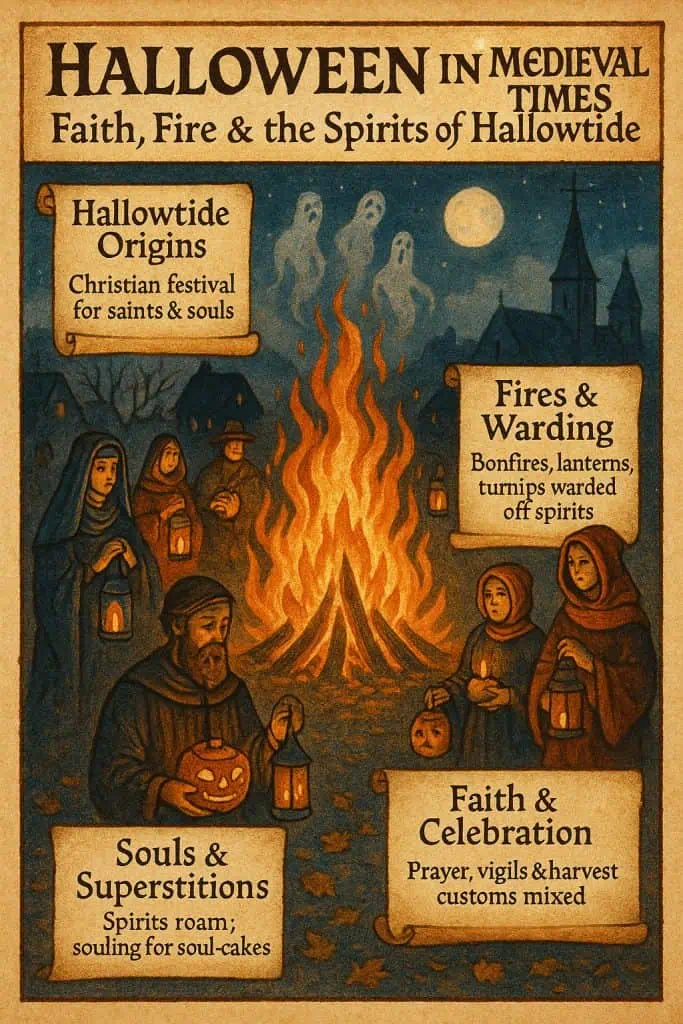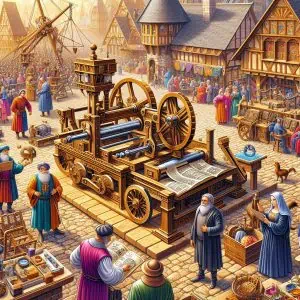Halloween as we know it today—with costumes, candy, and carved pumpkins—has its roots deep in the Middle Ages. While medieval people didn’t go trick-or-treating or light jack-o’-lanterns, they observed the same night with deep religious significance, bonfires, prayers for the dead, and symbolic rituals meant to protect the living from wandering souls. The medieval world called this sacred time Hallowtide—a three-day period that honored the saints, prayed for the departed, and bridged the living and the dead.

🔥 From Samhain to All Hallows’ Eve
Halloween’s story begins long before medieval times, in the ancient Celtic festival of Samhain (pronounced “Sow-in”). Celebrated in Ireland, Scotland, and parts of Wales, it marked the end of the harvest season and the start of winter. People believed that during Samhain, the veil between the living and the dead grew thin, allowing spirits to roam the earth.
When Christianity spread across Europe, the Church sought to transform these older pagan observances into Christian celebrations. By the 8th century, Pope Gregory III established All Saints’ Day (or All Hallows’ Day) on November 1st, followed by All Souls’ Day on November 2nd. The night before, October 31st, became known as All Hallows’ Eve—and over time, this sacred evening evolved into Halloween.
💀 Did You Know?
The word “Halloween” comes from “All Hallows’ Eve”—literally meaning the “evening before All Saints’ (Hallows’) Day.” Over time, the old English phrase “All Hallows’ Even” was shortened to “Hallowe’en.”
🍞 Souling, Guising, and Medieval Traditions
Between the 11th and 15th centuries, Hallowtide became one of the most important observances in medieval Europe. It was a period of prayer, remembrance, and community gathering, blending Christian faith with older folk customs.
🕯️ Souling
On All Hallows’ Eve and All Souls’ Day, the poor and children would go door-to-door offering prayers for the souls of the departed. In return, they received small round cakes known as “soul cakes”—a direct ancestor of today’s trick-or-treating. The tradition was known as “souling.”
👻 Guising
In parts of medieval Scotland and Ireland, people dressed in disguises—often as ghosts or saints—to protect themselves from wandering spirits. They performed songs, recited verses, or played small tricks in exchange for food, echoing the roots of modern costume traditions.
🎭 Did You Know?
The medieval practice of “guising” is where our modern Halloween costumes come from. It wasn’t for fun—it was meant to fool the spirits of the dead so they wouldn’t recognize or harm the living.

🔥 Bonfires and Bells
Bonfires were a hallmark of medieval Halloween nights. They symbolized light conquering darkness, and their smoke was believed to ward off evil spirits. Churches would ring bells throughout the night to guide the souls of the dead safely through purgatory—a custom known as “Soul Mass Night.”
🍂 Medieval Foods and Festivities
While there were no candies or pumpkins in medieval Europe, Hallowtide was marked by shared food and charity. People baked soul cakes flavored with nutmeg and saffron, gave out apples, nuts, and dried fruits, and hosted simple autumn feasts after the harvest. In rural villages, communal gatherings around fires often included storytelling about saints, spirits, and local folklore.
🍏 Did You Know?
Pumpkins were unknown in medieval Europe—they’re native to North America! Instead, people carved turnips and beets into lanterns to ward off evil spirits. These early “jack-o’-lanterns” were far scarier than our modern pumpkins!
🙏 Faith, Fear, and the Afterlife
In the medieval worldview, the boundary between life and death was thin, especially during Hallowtide. People genuinely believed that spirits of the departed could return to the mortal world. Churches held Requiem Masses, monks and nuns prayed for souls in purgatory, and families lit candles to remember the dead. What we now call “Halloween” was, to them, a sacred and solemn time of year—full of faith, fear, and reverence for the unseen world.
🕯️ Summary
Medieval Halloween—or All Hallows’ Eve—was not a night of playful scares, but a period of spiritual reflection and ancient tradition. From the glowing bonfires of Samhain to the prayers of All Souls’ Night, this medieval festival blended Christian devotion with Celtic mysticism, laying the foundation for the Halloween we celebrate today.
So, next time you light a jack-o’-lantern or dress up as a ghost, remember—you’re keeping alive a tradition that began more than a thousand years ago in medieval Europe.
🎃 Frequently Asked Questions: Halloween in Medieval Times
What was Hallowtide?
Hallowtide was the three-day medieval festival including All Hallows’ Eve, All Saints’ Day, and All Souls’ Day, honoring the dead and protecting against spirits.
Did medieval people celebrate Halloween like we do today?
No, modern Halloween traditions like trick-or-treating evolved later. Medieval celebrations focused on prayers for the dead, soul cakes, and some disguises.
What were soul cakes?
Small sweet cakes given to people who offered prayers for the deceased during Hallowtide, especially on All Souls’ Day.
What is souling?
Souling was the practice of going door-to-door offering prayers for the dead in exchange for soul cakes.
What is guising?
Guising involved dressing in costumes or disguises to ward off spirits, often accompanied by songs or short verses.
Which vegetable was originally carved for jack-o’-lanterns in medieval Europe?
Turnips and sometimes beets were used for carving jack-o’-lanterns before pumpkins became popular in North America.
What was the purpose of these early Halloween customs?
They were meant to honor the dead, protect the living from wandering spirits, and encourage prayers for departed souls.
🎃 Perfect Quiz: Halloween in Medieval Times
📜 References & Historical Sources
The following references and academic resources were consulted to ensure historical accuracy and depth in the research of Halloween traditions and Hallowtide customs in medieval Europe:
- Encyclopedia Britannica – Halloween
- History.com – The Origins of Halloween
All sources have been reviewed for factual accuracy and credibility to maintain the integrity of the content on Medieval Chronicles. Where applicable, historical records, ecclesiastical documents, and folklore studies have been cross-referenced with academic publications.
🎃 Halloween in Medieval Times Glossary
All Saints’ Day
A Christian festival on November 1st honoring all saints, often linked with early Hallowtide celebrations.
All Souls’ Day
Observed on November 2nd to remember the dead, with prayers, candles, and offerings for departed souls.
Hallowtide
The three-day festival from October 31 to November 2, encompassing All Hallows’ Eve, All Saints’ Day, and All Souls’ Day.
Souling
A medieval practice where people went door-to-door, offering prayers for the dead in exchange for soul cakes.
Soul Cakes
Small spiced cakes given to soulers during Hallowtide, representing prayers for departed souls.
Mumming
A form of medieval performance or masked procession during festivals, sometimes linked to Hallowtide.
Jack-o’-Lantern
Early traditions involved carving turnips or other vegetables to ward off evil spirits during All Hallows’ Eve.
Bonfires
Fires lit during All Hallows’ Eve to protect against spirits and guide souls of the dead.
Trick-or-Treating
An early medieval custom evolved from souling, where people collected food or offerings while honoring the dead.






